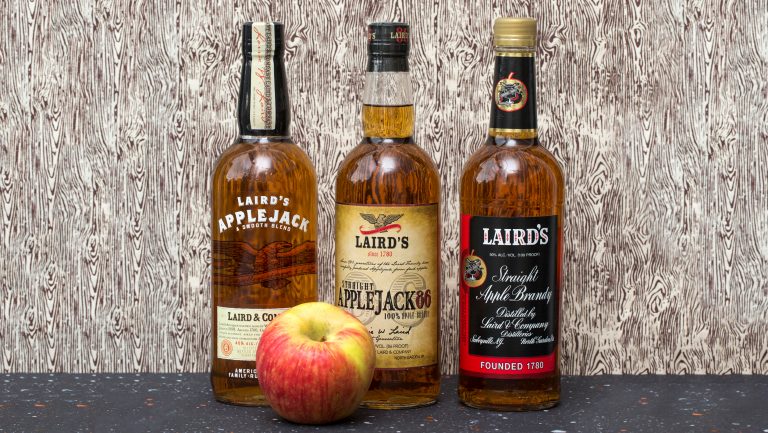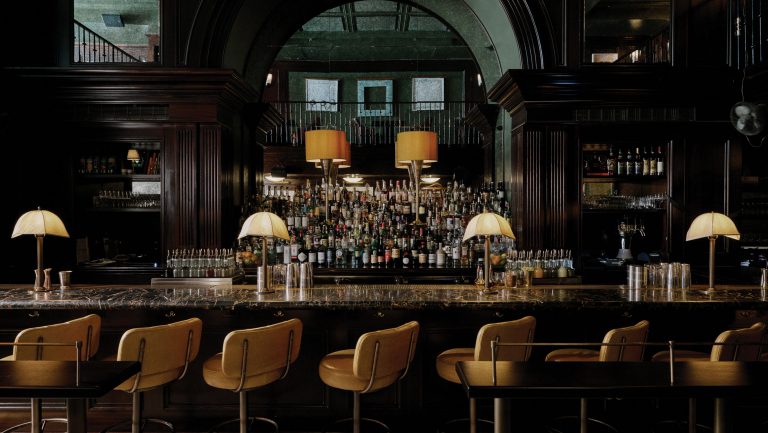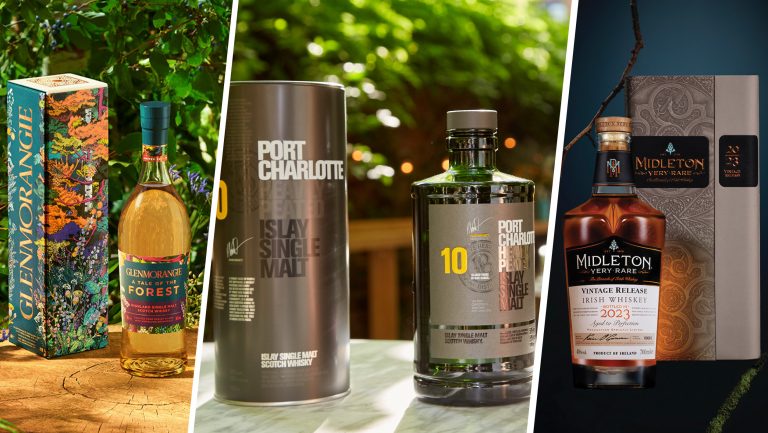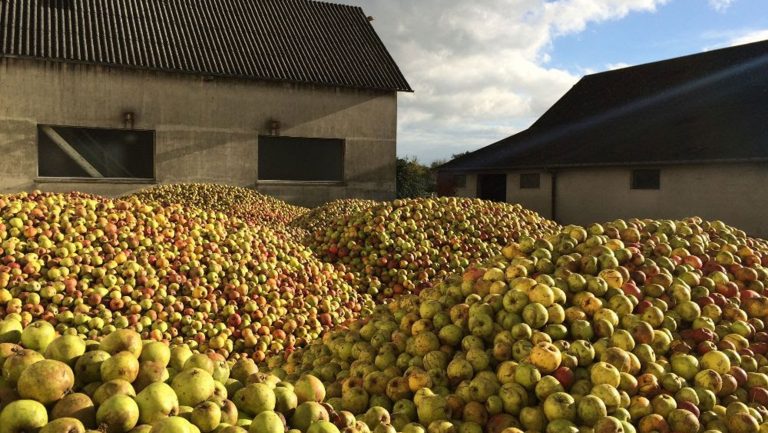Apple brandy has been a part of American history since the 18th century, when it was distilled by George Washington himself. The apple-derived spirit gave us Laird’s, the nation’s first licensed commercial distillery, in 1780—it’s the country’s longest-operating distillery as well. Yet, apple brandy still doesn’t rate highly in the minds of most drinkers as a quintessential all-American spirit—most consumers would probably give that distinction to bourbon, even though apple brandy predates bourbon in the U.S. by about two centuries.
Despite its storied history, apple brandy hasn’t reclaimed its colonial-era popularity. For decades, consumers have seen the product as a quaint throwback at best, a dusty relic at worst. But with consumer awareness slowly growing, and the added momentum of scrappy new craft producers, like Copper & Kings and Rhine Hall, who’ve joined Laird’s in the domestic brandy category, that reality might be about to change.
In September, Laird’s released its first new bottling in three years, Laird’s Straight Applejack 86, which Lisa Laird Dunn, the vice president of the brand and a ninth-generation Laird, describes as a bridge in style and in alcohol content between the distillery’s Blended Applejack (80 proof) and the its straight Apple Brandy (100 proof). Unlike the blended applejack, Laird’s 86 is a straight, uncut apple brandy aged for three years that, as Laird’s describes it, “revives the company’s historic pre-Prohibition 100 percent apple brandy at its post-Prohibition proof of 86 (43% ABV).” This alcohol content gives the 86 a more suitable backbone for cocktails than the Blended Applejack, says Laird Dunn, without the more aggressive heat of a 100-proof spirit, which also makes it a bit more palatable for sipping than the straight 100-proof brandy. “We felt that there was such a new resurgence of interest in the brandies,” she says, “so we wanted to offer what the product originally was.”

Don’t miss the latest drinks industry news and insights. Sign up for our award-winning newsletters and get insider intel, resources, and trends delivered to your inbox every week.
While it may be a stretch to think that apple brandy will catch up with the likes of rye and bourbon, the category is definitely growing, both in value and in production. Over the last decade, the volume of net brandy production recorded by the Alcohol and Tobacco Tax and Trade Bureau has ebbed and flowed with the passing years, but when the TTB compared 2016’s net brandy production to that of 2006, it recorded an increase of 35 percent (from 11 million gallons in 2006 to more than 15.5 million gallons in 2016), and an increase of 25 percent in gallons bottled for domestic use (from 15 million to 19 million). The TTB’s most recent report, from August 2017, shows a 17 percent increase in cumulative year-to-date bottling of brandy for domestic use compared with the same period from 2016, from 11 million gallons to 14 million gallons.
Additionally, according to Nielsen data, flavored brandy is up 6.4 percent year over year and apple brandy, which accounts for 20 percent of flavored brandy offerings, is up by a considerable 80.4 percent year over year—a remarkable comeback from roughly this time period two years ago, when the apple brandy segment saw a year-over-year decrease of nearly 16 percent.
“We continue to see interest in the apple brandy category among consumers,” says Shawn Thurman, the EVP of national accounts for Southern Glazer’s, the largest wine and spirits distributor in North America. “Now that we’re entering the fall and holiday season, we expect continued growth, as apple, cider, and other fruit flavors are favorites among bartenders creating seasonal cocktails.”
Setting the Stage for Growth
Apple brandy is certainly not unique to the United States. Fruit brandies, or eaux-de-vie, are found around the world; Normandy, in particular, is known for its Calvados and pommeaus, blends of apple brandy and apple juice. But “apple brandy goes back to the very beginning” in America, says Greg Best, whose Atlanta bar Ticonderoga Club draws thematic inspiration from colonial taverns and features both apple brandy and cider prominently on its menu. “Laird’s,” he says, “which is probably the most prominent and certainly the most time-tested [brandy] distillery, has been around … throughout our country’s entire distilling history.”
Indeed, not only has Laird’s been the leader in the category for more than two centuries, but for many years it was the only domestic producer of apple brandy and applejack (a blended brandy with a “jacked” alcohol content, which is typically accomplished nowadays by adding grain spirits). Laird Dunn says that being the only player didn’t exactly help spread consumer awareness about the category, because for the better part of American apple brandy’s history, there was no “category” to speak of. “For many years, we were the category,” she says. Laird Dunn contrasts the situation with the immensely successful educational efforts achieved by bourbon producers with initiatives like the Bourbon Trail. “There are many producers,” she says, “so they’ve worked together to build awareness.”
In the last decade, though, the category has begun to see the stirrings of a sea change as more craft producers enter the fray and more people—bartenders and consumers alike—are exposed to the product. Laird’s itself has seen a steady uptick in demand since 2005, when the brand began seeing double-digit growth. Laird Dunn cites the early proliferation of craft cocktail culture in the mid-aughts, and the resulting renewed interest in classic drinks like the Jack Rose (an applejack-based cocktail from the ’20s), for the initial surge. “[From 2005] through 2011, we saw 20 to 25 percent annual growth,” Laird Dunn says. Struggling to meet the sudden demand, Laird’s grappled with inventory problems and was forced to strictly allocate its brandies for several years. “As we have come off allocation,” says Laird Dunn, “we are currently at a 10 percent annual growth.”
A New Crop of Producers
In the last few years, the category has become a little less lonely for Laird’s. They say a rising tide lifts all ships, and a steady trickle of new craft producers entering the market had the same effect, according to Joe Heron of Copper & Kings, a distillery based in Louisville, Kentucky. “The apple brandy category has changed dramatically over the last five years or so from essentially a one-horse category,” Heron says. “[It] is growing very rapidly, and demand far exceeds supply right now.”
While Laird’s remains the stalwart, the new arrivals are adding creativity and unconventional methods. Heron characterizes the approach at Copper & Kings as “modern and adventurous,” with a proclivity toward higher-proof bottlings, an eye toward the needs of craft bartenders, and a flair for experimenting with, for example, barrel finishes, using Spanish sherry casks and tequila barrels in addition to the more traditional Kentucky bourbon barrels. “We bring a little rock and roll to the brandy category,” he adds (a statement one can take literally, based on the distillery’s “sonic aging” methodology, whereby it plays music to its barrels all day).
Rhine Hall, a family-run distillery in Chicago, relies strictly on fruit for its line of eaux-de-vie, which includes two apple brandies (one unaged, one aged in oak). Cofounder Jenny Solberg Katzman explains that Rhine Hall’s production style involves using the whole fruit, including the skin, which she says adds more flavor complexity. Best, of Ticonderoga Club, describes the unaged brandy as “fresh and vibrant, with an overtly botanical characteristic to it” that Ticonderoga Club bartenders tend to use in summer months—it’s a sharp contrast to the warmer, oakier, spiced flavor profile of apple brandy that often comes to mind.
Educating Buyers and Consumers
So is apple brandy finally getting its due in American drinking culture? Perhaps, but Best says brandy still has a way to go before it’s widely understood and appreciated by the average guest, thanks to middling consumer awareness and widely held outdated perceptions of the spirit. “I think it’s still a secondary category at best,” he says. “Most people who’ve been exposed to fine-dining trappings have an idea of something like Calvados, and what I mean by that is that they literally have an idea of what it is,” he says. Guests may have superficial and vague notions of brandy as something one sips from a crystal snifter after a white-tablecloth meal, but beyond that, little actual knowledge of what the spirit is. (Rhine Hall challenges these musty stereotypes with its branding: Katzman explains that the clean, modern aesthetic of the labels is meant to “bring a little bit of youth to the product category.”)
Compounding the lack of education and awareness, though, is the unfortunate fact that fruit brandies are simply more expensive to produce and difficult to justify in an industry that Best says has been formatted for grain distillates. “It’s just so cost prohibitive that a lot of these awesome brandies, when they came out, were just expensive as hell, so people didn’t even bother with them,” says Best. “I think that goes hand in hand with people’s lack of exposure to the category.”
Rhine Hall is one of the few producers to work solely with fruit brandies—without a flagship vodka or gin to offset its costs—and Katzman acknowledges that this isn’t the most lucrative path. “It’s one of the more difficult products you can make … in terms of the type of equipment you need, as well as the volatility of the fruit market,” she says. Pursuing it without being able to rely on a cash flow-friendly product like vodka to supplement revenue is challenging. But ultimately, Katzman says, Rhine Hall wants to focus on doing one thing exceptionally well. And given that the craft food and drink renaissance of the past five or ten years means that people are more willing to try new things, explore craft goods, and learn how they’re made, she says, “I think it will start becoming a little bit more of a sought-after product for the consumer.”
Not only does apple brandy have a rich history, but it’s also an exciting and challenging spirit for bartenders to work into cocktails. “We love that aged apple brandy can have the eccentricity and spice and structure of a great whiskey, but because it’s a fruit-based distillate, you just have more of a round, more aromatic base,” says Best. Heron sees it not only as a versatile ingredient in cocktails but also as a natural next step for fans of another spirits segment that’s seen a remarkable boom in the last decade: whiskey. “The way I look at it is, apple brandy is the rye to grape brandy’s bourbon,” he says. “A little spicier, feisty, and in terms of scale, the little brother growing up very fast.”

Dispatch
Sign up for our award-winning newsletter
Don’t miss the latest drinks industry news and insights—delivered to your inbox every week.
Gray Chapman is an Atlanta-based journalist who writes about spirits, beauty, and culture; she was formerly the managing editor of Tales of the Cocktail. Follow her on Twitter.







